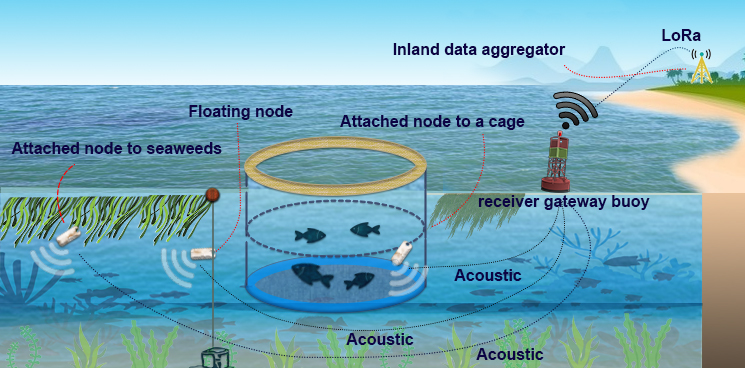IMPAQT ultrasonic underwater telemetry platform
Integrated multi-trophic aquaculture (IMTA) is gaining popularity due to its sustainability, environmental impacts minimization and economical promotions. IMPAQT is a European project aimed at promoting and supporting inland, coastal zone and offshore IMTA development. As a part of IMPAQT project, we are developing a novel biotelemetry platform in WSN Group of Tyndall national institute . Our platform is consist of Underwater Transmitter Nodes (UWTN) and receiver gateway nodes to provide an underwater sensors networks platform to monitor and analyze marine environments. Each UWTN is capable of integrating sensors such as accelerometers and temperature sensors, that can be immersed in water and IMTA sites to monitor water flows, seaweeds movements and marine animals’ activities.

Quick takeaway
1- What is the problem that we are focusing on?
Real-Time (Instant) wireless aquatic monitoring sensors, currently few companies provide products real-time underwater monitoring systems, they are mostly expensive or need wires to communicate
2- What do we offer?
Simply, we are trying to eliminate the need for the wire using our novel miniaturized ultrasonic transceiver modules , which results in unlocking the potential for various technologies and sensing methods, such as real-time monitoring of fish health, seaweed or water quality. Our second target is to build novel, miniaturized sensors based on our miniaturized transceiver modules. We are hoping to help farmers in following areas : Non-stop, real-time monitoring of the sites, Early disease detection using respiratory frequency monitoring, feeding optimization, fish stress detection and seaweed growth optimization . However, we are at the early stage of technology development; these points are the hypothesis that we are planning working on.
3- At what stage we are?
Currently, we have the prototype of our system ready. We are working closely with our partners in the IMPAQT project, Marine Institute and others, to test and improve the devices. We will also deploy some of the developed sensors in West Galway for data collection and testing soon.
4- What are we looking for?
At the moment we are looking for any potential stakeholders to discuss with, regarding what they need most, what would be the optimal solution they are looking for and what would be their ideal definition of a novel miniaturized monitoring sensor. We are also open to any partnership from the industry for collaboration on the problems and providing the solutions. We would be happy to plan a virtual meeting (considering the current pandemic situation) to talk more in details.
Why our project is important ?
With the advancement of communication technologies, it is now possible to transmit a data over hundreds of kilometres in the air using electromagnetic waves, however as soon as the medium changes from air to water, communication range using electromagnetics drops to few meters in freshwater and less than a meter in seawater due to water properties and conductivity which makes the implementing of underwater wireless sensors networks challenging. RF, acoustic and optical communication links are the commonly used methods of underwater communications. However, the conductivity of water can cause severe attenuation and absorption to the RF signals. To tackle this issue, high power transmitter and large antenna size are required, which is not suitable for most aquaculture monitoring applications. Optical communications need a clear line of sight, and acoustic communication suffers from limited bandwidth, propagation delay, and multipath effect. In this research project, we are studing the the challenges of developing an underwater telemetry platform and we are developing a novel telemetry platform to tackle the discussed issues.
Do you need more information ?
- Recent publications :
-
IMPAQT Miniaturized Underwater Acoustic Telemetry Platform: Transmitter Node System Design -Best Paper Award- Open Access -
Download From here - Presentation File Presentation video
- An Interview with Hamed Jafarzadeh, Tyndall National Institute of Ireland - To watch the interview click here
I'm currently working in Tyndall national institute under supervision of Dr.Brendan O'Flynn and Marco Belcastro with the advising of Dr.John Barton .